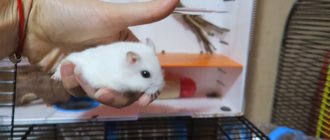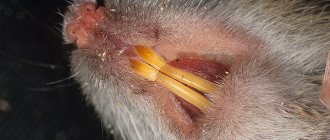Decorative rats can suffer from mange even with proper care - the reasons for this are varied, from nutritional disorders to allergies. Scratching on the skin can also be a sign of a number of diseases. What to do if a rat itches until it bleeds? First you need to examine the animal for other signs and observe its behavior. There are several common causes of scabies that can be quickly identified by additional symptoms.
Stress
Most often, this reaction manifests itself when purchasing an animal, but an adult ornamental rat can also experience stress when its usual conditions change. In this case, itching on the skin is caused by nervous tension. Usually the rat not only itches, but also shows signs of anxiety and panic - it runs around the cage, or, on the contrary, hides in the house and loses its appetite. The best solution is to identify the cause and remove the irritant, and let the rat rest, start adding vitamins and the Anti-Stress drug to the normal diet.
IMPORTANT: If you have just brought home a new animal, it needs to be rested for at least three days. Place a house in the cage where the animal can hide, and do not try to pick it up. Most rats begin to come out of hiding and actively explore the cage on the second day. But if you come across a timid little rat, you may need a much longer period.
Excessive washing
The Rat may groom itself or others excessively. Causes include stress, overcrowding or incompatible social groups.
Excessive washing of the animal will prevent external skin lesions such as scabs and ulcers. Body hair may be broken in just one area or all over the body, but the skin underneath should be intact.
Treatment may include trial separating animals through a mesh partition or reducing overcrowding. If this is not possible, try increasing the available space with additional hanging hammocks or tunnels.
Read also: How to make a niche with shelves from a window
Cage conditions and hygiene
If there are no obvious reasons for stress, and the rat often itches, you should check the conditions of its detention. Perhaps the litter does not absorb moisture well, so more frequent cleaning or changing the filler is required. Also, the reason may be the uncleanliness of the animal itself - not all rats take equally good care of their fur. If the animal is not litter box trained, the fur may become saturated with urine, causing irritation and severe itching of the skin. Change the filler, keep the cage clean and regularly give the animal warm baths with special shampoo, which can be purchased at a pet store. Many decorative rats especially love bathing and always enjoy water procedures.
Prevention
Decorative rats should be kept clean, regularly change the bedding, wash the cage, feeder, drinking bowl with disinfectants, and then wash the surfaces with clean water and dry. Before exhibitions and the introduction of new animals, the rat is given preventive treatment against parasites.
To avoid allergies, the filler should not be made of coniferous wood. Rats are often allergic to protein in their diet, artificial colors, flavors, and taste enhancers. To determine this, when scratching, the rat is transferred only to ready-made dry food, adding one product a little at a time and monitoring the body’s reaction.
Rats, like other animals, need to be examined regularly to prevent further development of the disease. To visually inspect rats, experienced breeders use a magnifying glass or strong lens. If scratches and wounds are associated with mechanical damage, the rats must be seated and sharp objects hidden.
Mechanical damage to the skin
If a domestic rat is kept in the company of relatives, it can get wounds and scratches in a fight or even during play. Damaged areas of the skin are very itchy during healing, and infection can also get into the wounds. If you notice that one of the rats is itching until it bleeds, while the others are not showing any symptoms, the first thing to do is put the animal in a separate cage. Then carefully examine the animal, rinse the scratched areas with 3% hydrogen peroxide, lubricate with antibiotic ointment (tetracycline or levomekol
). If the wounds are deep or inflamed, it is better to consult a veterinarian.
Other diseases
In addition to skin problems, severe itching can be caused by liver and kidney diseases, malfunctions of the gastrointestinal tract, infectious, viral or fungal invasions.
In these cases, in addition to itching, the following symptoms can be noted: discharge from the eyes and nose (reddish), stomach upset, apathy, loss of appetite.
If a rodent scratches its eyes, conjunctivitis may develop.
Worm infestations also cause scabies , but before treatment for helminths you should get tested; most antiparasitic drugs are quite toxic. Only after confirming the diagnosis, the veterinarian will calculate the required dosage, taking into account the weight and characteristics of the rat.
Allergic reaction
Allergies are one of the most common causes of itchy skin. If you notice that your rat is scratching its neck and sides, this reaction can occur for several reasons:
- unhealthy diet - poor diet, excess protein foods;
- harmful foods - rats are omnivores, and domestic animals are often treated to forbidden delicacies from the human table (sweet, salty, fatty);
- chemical components of the filler;
- bedding made of unprocessed fresh sawdust with an excess of resins and oils;
- printing ink on newspapers used for bedding;
- detergent compositions, cage cleaning powders.
The allergic reaction often manifests itself in the form of severe, persistent itching, so the rat scratches itself until it bleeds. It is necessary to check all possible causes of symptoms, try to identify and exclude the allergen. Put the animal on a strict diet, change the litter, and clean without household chemicals.
Dangers to rats
To begin with, you need to figure out how and what animals can get sick with, and how this can be expressed. So, a rat may experience:
• Allergic reactions
• Colds and respiratory diseases
• Infectious diseases
• Fungal diseases
• About swelling
In addition to the above, animals can be bothered by lice, fleas, ticks, and bedbugs. Being carriers of the infection themselves, they easily transmit it, especially to weakened immune systems. They can also pose a danger to humans!
Avitaminosis
A lack of various vitamins can manifest itself in different ways - lethargy, sneezing, itchy skin, hair loss, the appearance of ulcers and sores on the skin. The cause of the disease is an improperly balanced diet, lack of grain, herbs, fruits and vegetables. A severe lack of vitamins can lead to decreased immunity, metabolic disorders, and the development of serious diseases. For a correct diagnosis, it is better to consult a doctor, who will prescribe a series of injections and create the correct diet for the sick animal.
If no serious symptoms are observed, the animal is active and does not lose appetite, then you can buy a regular vitamin complex at a veterinary pharmacy. Typically, such additives are prepared in the form of granules, which are convenient to add directly to the feed.
Prevention
To avoid problems with your pet’s skin, it is necessary to carry out all hygiene procedures on time, as well as monitor the quality and cleanliness of the bedding and filler. In addition, it is advisable to maintain optimal levels of temperature and humidity in the room where the rat lives. And the diet must contain all the necessary substances to ensure the normal development and good health of the animal.
If you follow all the rules for caring for rats, check the cleanliness of their skin and fur in a timely manner, and also feed them correctly, problems such as itching should not arise. And if they appear, it is advisable to immediately seek help from a specialist who will help determine the cause and prescribe the correct treatment.
Was this article helpful? Yes No Has already helped 23 times
Parasite infestation
Many types of skin parasites also cause itching, causing rats to scratch until they bleed. flea activity
and the insects themselves can be easily seen on the skin when examining the animal.
Flea infestation
But also often domestic rats become infected with subcutaneous mites
, which cannot be seen without special instruments.
If, in addition to mange, you notice bald spots on the fur, the animal is probably infected with lice eaters
. Wash the rat with a special anti-parasitic shampoo; it is also advisable to apply drops to the withers.
Infestation with lice eaters
IMPORTANT!!! Many owners buy flea drops intended for cats or kittens to treat domestic rodents. Do not forget that significantly lower dosages are required for rats - to avoid poisoning, be sure to weigh the animal, then calculate the amount of the drug by weight. It is best to use products designed specifically for rats.
Ectoparasites
Ectoparasites such as demodex, notoedrosis, sarcoptic mange, and lice eater can cause similar symptoms in decorative rats. These are subcutaneous mites, and the main difficulty is that only a doctor can detect their presence by conducting the necessary research - laboratory tests and scraping of the deep layers of the skin. The appearance of claw marks in the ears and head, as well as the occurrence of dandruff and partial alopecia may indicate damage by ectoparasites.
Signs
The rodent is not active, the appetite has disappeared, the rat is itching, and partial alopecia may be observed.
Treatment
You need to understand that treatment for such lesions takes a long time. It is necessary to treat the animal with antiparasitic solutions, for example, Ivermectin. Independent use of this drug is unacceptable, because It is used for animals of large breeds; for a rat, only a veterinarian can calculate the required dose of medicine. If used incorrectly, it can cause intoxication and subsequent death of the pet. After cure, a repeat analysis (scraping) is necessary. Antiparasitic shampoos are used as a preventive measure.
If you purchased drops that are indicated for cats and dogs to treat skin parasites, do not forget about the dosage.
A rat is much smaller and an incorrectly calculated medicine can cause poisoning. Experts advise purchasing products suitable specifically for rats.
Diagnostics
The diagnosis of “allergic stomatitis” is made by a dentist based on an examination of the oral cavity and questioning the patient about underlying diseases and medication use. The dentist clarifies the clinical picture of the disease.
The doctor must conduct a comprehensive examination and diagnosis:
- removable and fixed prostheses;
- braces;
- filling
To clarify the clinical picture of the disease, the specialist refers the patient for a comprehensive blood and urine test and an immunogram to assess the state of the immune system. If necessary, the doctor sends the patient for the following studies:
- determination of the acidity level and composition of saliva;
- identification of the activity of enzymes contained in saliva;
- leukopenic test;
- provocative tests with removal and subsequent installation of prostheses.
An integrated approach to diagnosing allergic stomatitis will allow you to quickly find out the cause of the negative reaction, eliminate it and begin effective treatment.
Types of stomatitis
Depending on the nature of the disease and its clinical manifestations, experts divide catarrhal, catarrhal-hemorrhagic, as well as bullous, erosive, ulcerative-necrotic and allergic stomatitis.
The latter, in turn, is divided into the following types:
- medicinal;
- contact, for example, as an allergy to dentures, braces, plates;
- catarrhal;
- catarrhal-hemorrhagic;
- ulcerative-necrotic;
- erosive.
From the point of view of etiology and pathogenesis, allergic stomatitis includes medication, contact (including dentures), toxic-allergic, autoimmune dermatostomatitis, chronic recurrent aphthous stomatitis and other forms.
Depending on the speed of development of the reaction, doctors distinguish immediate and delayed types of allergic stomatitis. In the first case, angioedema is observed, and in the delayed type, the reaction to a particular irritant usually appears a few days after contact with the allergen.
In rare cases, allergic stomatitis develops while wearing dentures. Sometimes a reaction occurs even after 5–10 years of wearing them, after a long asymptomatic period.
Ask a Question
Our services for the examination, prevention and treatment of diseases of domestic rats
| A visit from a veterinarian to your home | 500 rub. |
| Examination, diagnosis, prescription of treatment for the rat | 1000 rub. |
| Trimming a rat's incisors | 500 rub. |
| Trimming rat's claws | 500 rub. |
| Therapy for the rat | From 200 rub. |
| Surgery for a rat | From 3000 rub. |
| Euthanasia | 1000 rub. |
A complete list of services provided by the specialists of the veterinary service Paw of Help for Your Pets>>
Mites on birds
Northern bird mites and chicken mites parasitize poultry. The first lives permanently, the second leaves the owner after feeding and hides in secluded places. They can cause anemia and weight loss. These mites are difficult to control; they are resistant to many insecticides.
Scaly leg mites are easier to kill. It affects the paws by feeding on the skin, causing the scales to rise, causing pain and discomfort.
Beaphar spray Milben-Zerstauber (Netherlands) will help get rid of all parasites. It kills mites as soon as they attack the treated bird. The solution is applied against the growth of the feathers until they become damp. Then the procedure is repeated after 2-3 days. Important: weak birds and those hatching eggs should not be treated.











